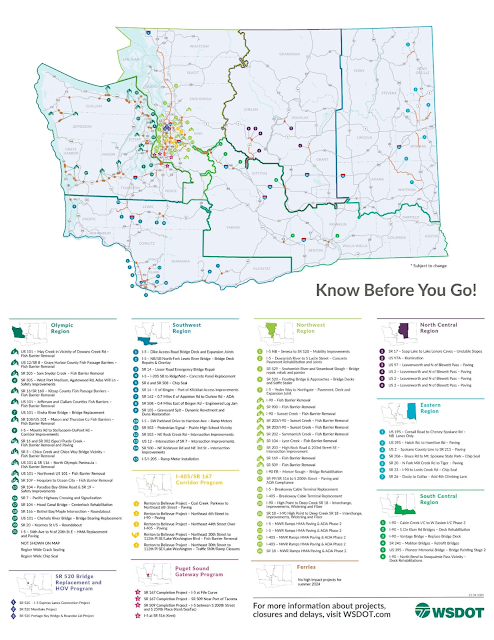By Rachel Terlep
It's a tale as old as time. You grab your crop top or your cowboy hat, and you head to that concert you bought tickets for back in February. You roll down the windows, turn up the music and… construction. Great.
Don't take it personally. If you're heading to a big event this summer, you're almost certainly going to encounter road work along the way. In fact, it's impossible to find a summer weekend – or even a day – where there's not a concert, game, festival or event going on.
With 93 construction projects scheduled this summer – not counting day-to-day maintenance, emergencies and local city and county projects – there is a lot to get done in a short timeframe.
 |
| It's going to be a busy summer with 93 projects planned on and near state highways, not including other regular maintenance or emergency repairs. See a larger version of this image on Flickr. |
That's just this year. Speaking of which, we have some good news and some not-so-great news.
The good news is once the work is done, our state will have safer and more accessible transportation systems and improved environmental habitats. The not-so-good-news, at least for the next few years, is that we'll have more summer construction projects than usual all over the state. And we do mean all, so your regular detours around major routes may have work as well.
 |
| We'll be seeing a lot of construction projects this summer. This photo takes us down memory lane… to the summer of 2022, when we were putting the finishing touches on the I-5 Tacoma HOV program. |
Why this time of year? Much of the work we do in the summer involves extensive work with concrete, and that means we need reliably dry weather for the concrete to fully cure. It also happens to coincide with a time when most of our professional sports teams are active, when we get a huge influx of concerts and when we have major events and festivals like Seafair, Watershed and Bumbershoot. That's not to mention the hundreds of smaller parades, community festivals and other events scattered throughout the season.
This is a calendar of major events happening in our state from June through September to give you an idea of why it's impossible to plan construction around those events. This calendar was created in early June, so other concerts and events may be announced as we move through summer.
How do you prepare for disruptions to your travel for the next several summers? Here's some advice from some of the musicians performing here this summer. Make sure this doesn't describe you: Salió de su casa con la mente encendida (In the words of Peso Pluma: “She left her house with her mind on fire.”)
YOU YOU YOU OUGHTA KNOW (Alanis Morissette)
Know what's happening, that is. We try to share information far and wide – from our social media accounts, to our website and app, to working with local media to get the word out. You can find our app and a list of our social media accounts at this website (scroll to the bottom to sign up for email/text alerts).
YOU SHOULD PROBABLY LEAVE (Chris Stapleton)
Early, if you can. Give yourself plenty of time to reach your destination.
G-O-O(d) T-O G-O (Chappell Roan… with a WSDOT twist)
You can take a Good to Go! It's handy if you'll use the SR 520 bridge or the SR 99 tunnel in Seattle, or I-405 to avoid heavy I-5 traffic, or possibly SR 167 to go to the Puyallup Fair or White River Amphitheater, or of course the Tacoma Narrows Bridge. Having a Good To Go! pass will also save you money and ensure you pay the lowest toll rate on all these roads. You can sign up or get more information on our website.
5 A.M. TURN THE RADIO UP (Pink)
And pay attention to road alerts. P re-program vehicle radios to 530 AM and 1610 AM for highway advisory radio alerts – and be alert for other stations listed on notice signs in some areas.
THERE GOES MY HERO / HE'S ORDINARY (Foo Fighters)
This is what we'll say about you if you consider alternative ways to get around – such as buses, bicycling, Link Light Rail, the Sounder Train, Amtrack Cascades or even organizing carpools. One great thing to keep in mind for people going to Climate Pledge Arena in Seattle: Every ticket to an event at the venue is also a transit pass.
I'M SO SICK OF SEVENTEEN…minute delays (Olivia Rodrigo…with a WSDOT twist)
There's not much you can do about that, but it's good to be in the right mindset before getting in the car. Accept that delays will happen. Try to stay calm. No concert or meeting or festival is worth risking injury or death.
IS IT WORTH IT? LET ME WORK IT (Missy Elliott)
We know added delays aren't fun, and we're working to minimize the effects where we can. We simply must make these repairs and improvements to our transportation system. Ultimately, some short-term pain will be worth the long-term gain.























